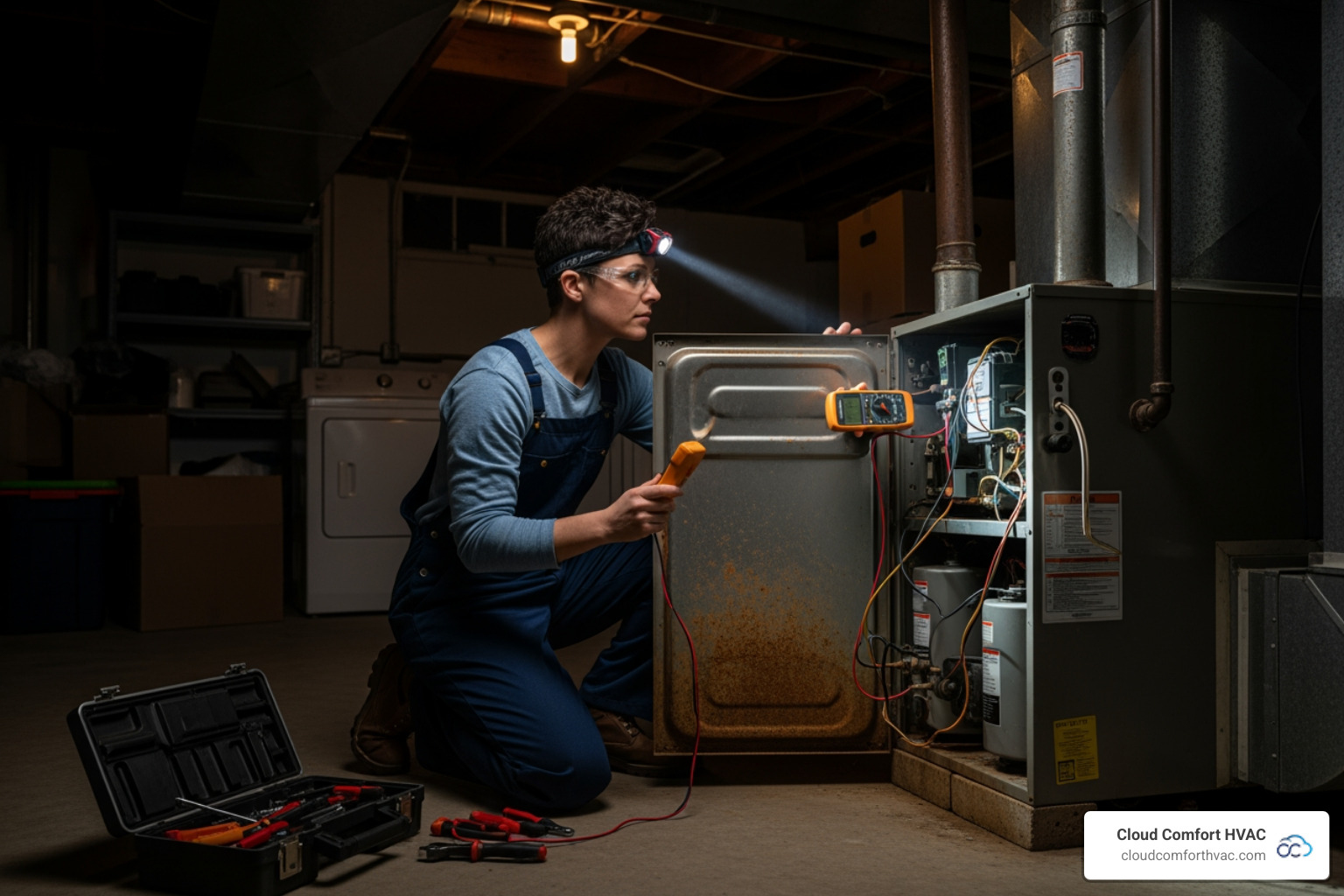Don't Get Left in the Cold: Troubleshooting Your Heater
Why Isn't My Heater Working?
When you wake up to a chilly house, you know something is wrong with your heating system. Heating system problems can be frustrating, but many have simple solutions you can handle yourself before calling a professional.
Most common heating system problems and quick fixes:
- Thermostat issues: Check batteries, settings, and ensure it's set to "Heat."
- Power problems: Inspect circuit breakers and the furnace power switch.
- Clogged air filters: A dirty filter restricts airflow and can shut the system down.
- Blocked vents: Clear furniture and other items from supply and return registers.
- Full condensation pan: Empty the drain pan to allow the system to operate.
According to HVAC experts, these simple issues cause a large percentage of "no heat" service calls. Understanding these basic checks can save you time and money. Common symptoms that signal trouble include the system not turning on, blowing cold air, making strange noises, producing unusual smells, or cycling on and off too frequently.
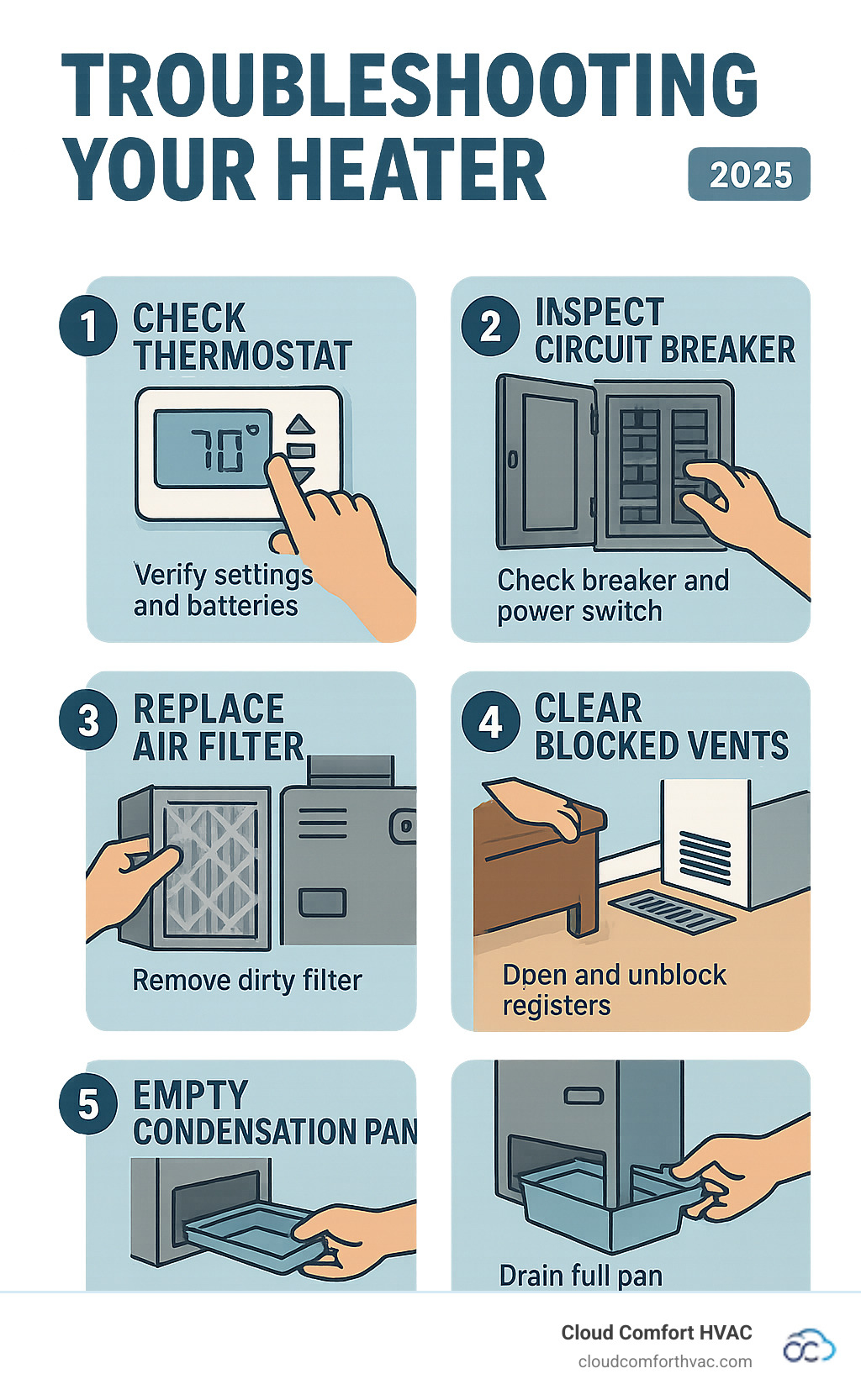
Start Here: Simple DIY Heater Troubleshooting Steps
When your heater fails, don't immediately call for help. Many heating system problems have simple solutions you can perform yourself in minutes, much like checking a car's battery before calling a tow truck.
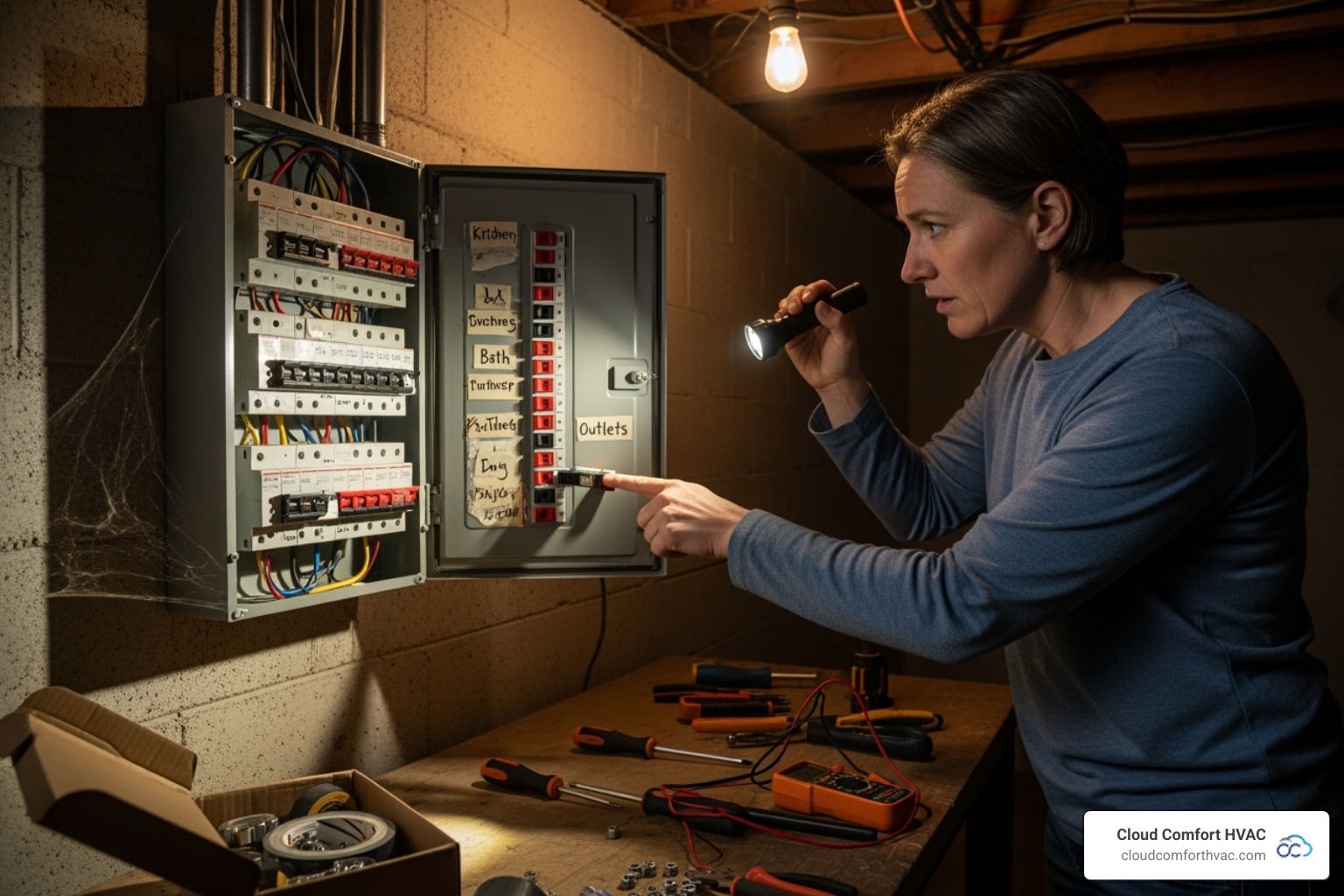
These simple furnace fixes can often restore warmth without the cost or wait for a technician.
Check Your Thermostat
Your thermostat controls your heating system, and it's a common source of problems. First, ensure it's set to "Heat" mode and the temperature is set higher than the current room temperature. A blank or dim display on a digital thermostat usually means it needs fresh batteries. Even if the display works, weak batteries can cause issues. If you have a smart thermostat, try restarting it by removing it from its base for 30 seconds to resolve potential software glitches. Also, check its location; direct sunlight or a nearby lamp can make it read the room as warmer than it is, while a drafty location can cause false cold readings.
Inspect for Power Issues
No electricity means no heat. Start at your electrical panel and look for a tripped circuit breaker dedicated to your furnace. If it's tripped, switch it firmly to "off" and then back to "on." Next, find the furnace power switch, which looks like a light switch on or near the unit, and make sure it hasn't been accidentally turned off. For gas furnaces, confirm the gas valve is open. If you have an older system, check if the pilot light is lit. Some furnaces also have a reset button (usually red or yellow) on the blower motor; you can try pressing it once.
For more detailed guidance, the Family Handyman has some helpful simple furnace fixes.
The Importance of a Clean Air Filter
A dirty air filter is one of the most common causes of heating problems. When clogged with dust and debris, it chokes your system, preventing proper airflow.
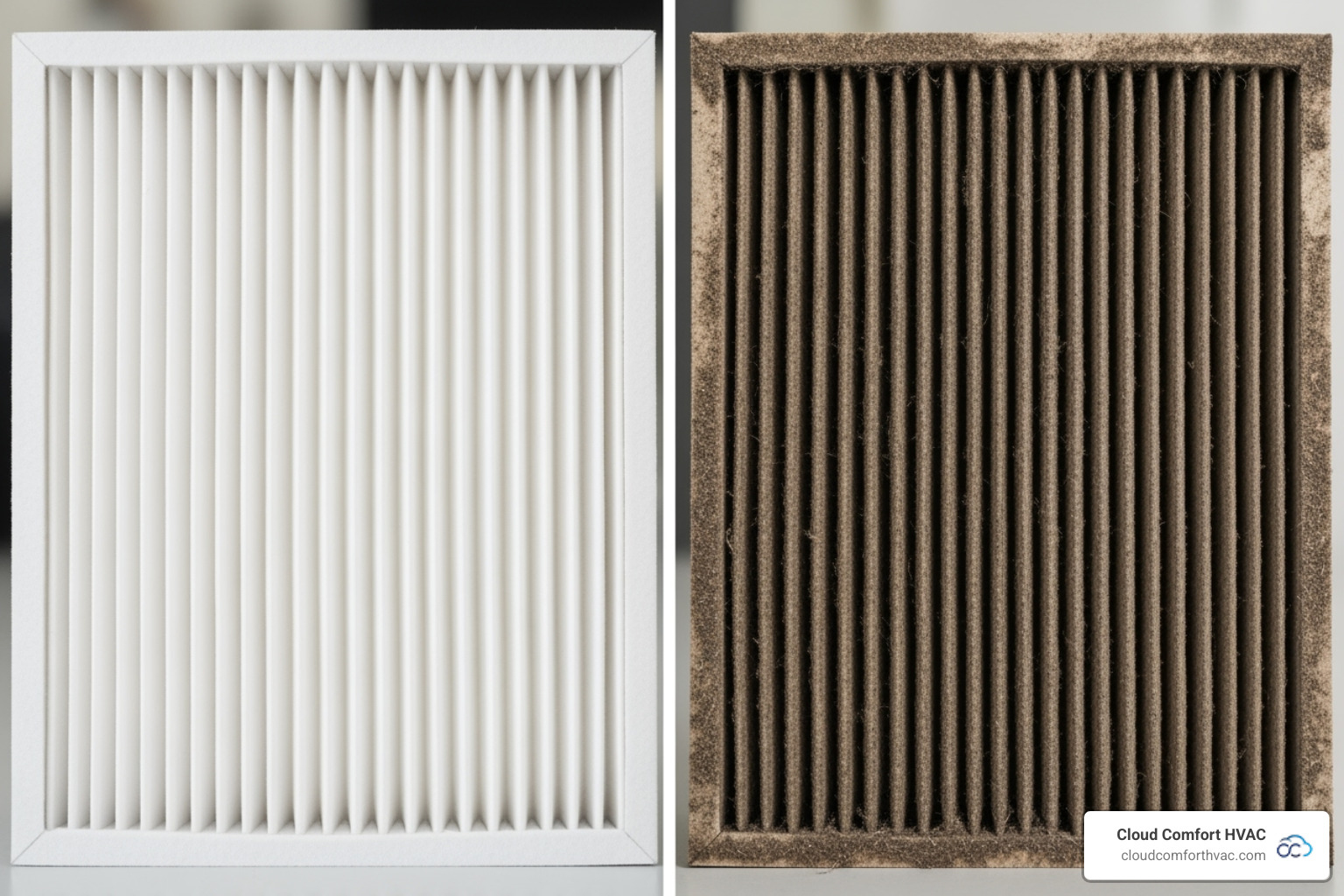
This leads to several issues:
- Restricted airflow: The system runs, but warm air can't reach your rooms effectively.
- System overheating: Trapped heat can cause safety switches to shut the furnace down.
- Higher energy bills: The system works harder and runs longer, wasting energy.
- Complete shutdown: Overworked motors can fail, leading to a total system breakdown.
Check your filter monthly. If you can't see light through it, replace it. Most homes need a new filter every 1-3 months.
Clear Vents and Registers
Even a powerful heating system is useless if the warm air is blocked. Blocked vents can cause uneven heating and reduce comfort. Walk through your home and ensure all supply vents and return registers are clear of furniture, rugs, or other obstructions. Closing vents in unused rooms can create pressure imbalances in your ductwork, forcing the system to work harder and potentially overheat. Maintaining proper airflow balance is a simple fix for better comfort and efficiency.
Common Heating System Problems and What They Mean
When your heater acts up, its symptoms can tell you what's wrong. Understanding these signs helps determine if it's a simple fix or time to call a professional. Most heating system problems involve strange noises, a lack of heat, erratic operation, or water leaks.
Identifying and Addressing Noisy Operation or Unusual Odors
A quiet hum is normal, but loud noises or strange smells are a call for attention.
- Banging or popping sounds at startup often mean dirty burners or a delayed ignition in a gas furnace. Gas builds up and ignites at once, causing a small bang.
- Whistling or hissing usually points to an airflow problem, like a clogged filter or leaky ductwork.
- Squealing or grinding noises suggest a problem with the blower motor, such as worn bearings or a failing belt. Address these sounds quickly to prevent complete motor failure.
Regarding smells:
- A burning dust smell is normal for the first run of the season and should disappear quickly.
- Burning plastic or electrical smells are serious. Turn off your system immediately, as this indicates a fire risk from overheated wiring or components.
- A rotten egg or sulfur odor signals a potential gas leak. Evacuate your home immediately without using any phones or light switches, and call your gas company from a safe location.
Your Heater is Running but Not Heating
It's frustrating when your system runs but blows cold air. This usually points to a problem with heat generation.
- For gas systems, check your fuel supply. Ensure the gas valve is open and your propane tank isn't empty.
- Ignition issues are common. An older furnace's pilot light may be out. In newer systems, a dirty flame sensor may fail to detect the flame, causing a safety shutdown.
- Heat pumps struggle in very cold weather (often below 40°F, though some work at a low-temperature threshold of 25°F) and may blow cooler air. A refrigerant leak can also prevent a heat pump from heating effectively.
Your Heater is Short-Cycling or Won't Turn Off
Short-cycling is when the heater turns on and off in rapid succession. The most common cause is an overheating system due to restricted airflow from a dirty filter or blocked vents. An oversized heating unit can also cause this. A faulty thermostat may also send incorrect signals.
If your system won't turn off, check the thermostat's fan setting. If it's on "On" instead of "Auto," the fan will run continuously. A faulty thermostat or a stuck relay in the blower motor could also be the culprit.
Water Leaks and Condensation Issues
Water around your furnace should never be ignored.
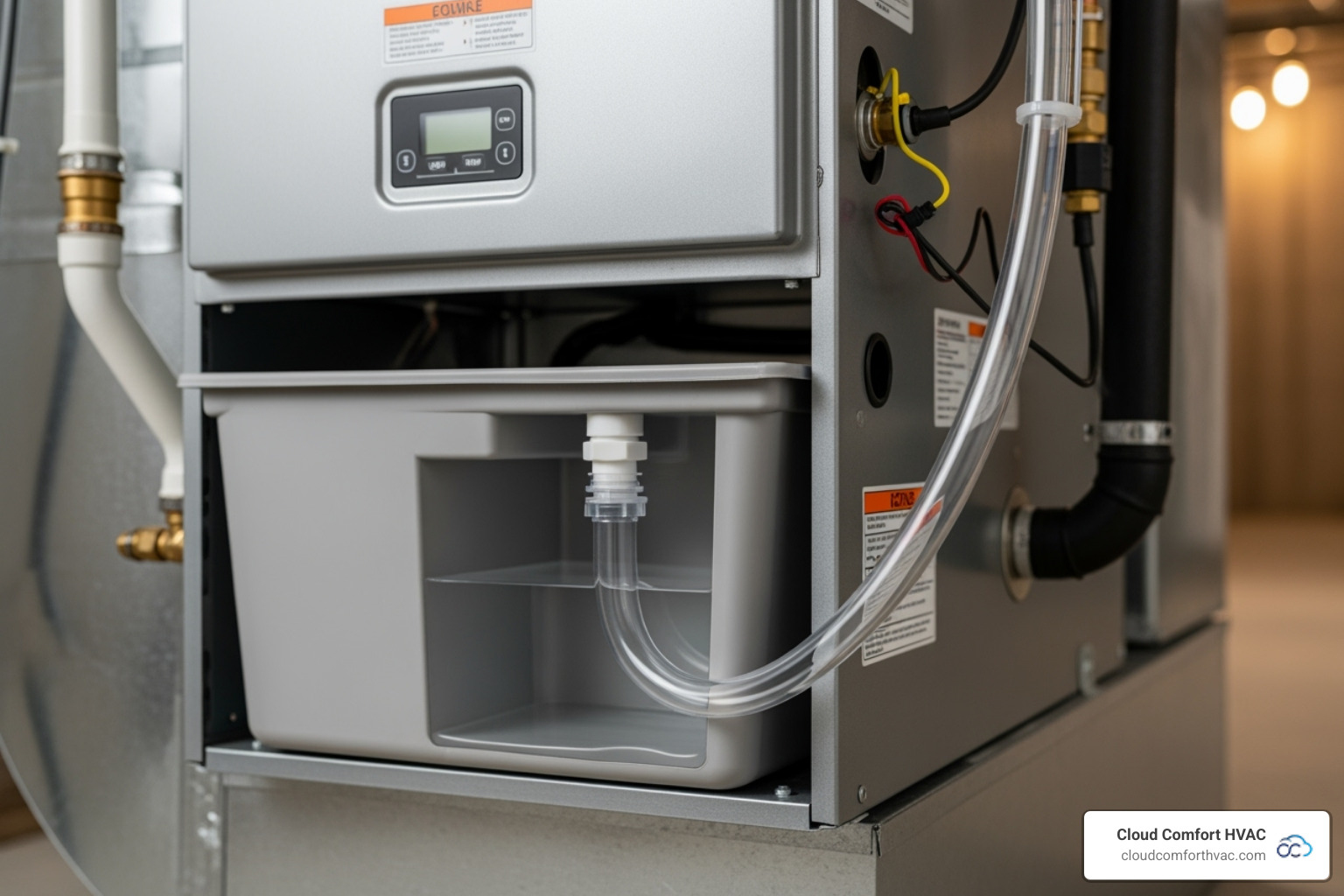
High-efficiency furnaces produce condensation, which is collected and drained via a condensate line. If this line clogs with debris, water will back up and overflow. Many systems have an automatic shut-off switch that activates when the drain pan is full, stopping the furnace to prevent water damage. If your system is off, check for a full pan and clear any clogs in the drain line. A leak could also come from an attached whole-home humidifier.
System-Specific Issues: Furnace, Heat Pump, and Boiler Problems
While some heating system problems are universal, troubleshooting is more effective when you understand your specific system type. Furnaces, heat pumps, and boilers each have unique components and common failure points.
| Problem Type | Furnaces | Heat Pumps | Boilers |
|---|---|---|---|
| Ignition Issues | Failed ignitor, dirty flame sensor, pilot light problems | Electronic defrost board malfunction | Ignition transformer failure, burner problems |
| Heat Production | Cracked heat exchanger, burner problems | Refrigerant leaks, reversing valve failure | Low water pressure, kettling sounds |
| Airflow Problems | Blower motor failure, ductwork issues | Outdoor unit icing, indoor coil freezing | Circulation pump failure, air in radiators |
| Safety Concerns | Carbon monoxide risk, gas leaks | Electrical issues, refrigerant leaks | Pressure relief valve problems, water leaks |
| Seasonal Issues | Dust buildup after summer break | Cold weather performance loss | Expansion/contraction of pipes |
Common Furnace Problems
Furnaces create heat by burning fuel, which leads to specific issues. Ignitor failure is common; these fragile ceramic parts crack or burn out after 4-7 years. A dirty flame sensor can also cause problems, shutting the furnace down as a safety measure because it can't detect the flame. The blower motor, which circulates air, can fail due to worn bearings, causing squealing or grinding noises. The most serious issue is a cracked heat exchanger, which can leak dangerous carbon monoxide into your home and requires immediate professional service.
Common Heat Pump Problems
Heat pumps move heat instead of creating it. During cold, humid weather, the outdoor coil can ice over, and the unit will enter a defrost cycle, temporarily blowing cool air indoors—this is normal. However, if the defrost system malfunctions, excessive ice can block airflow. A faulty reversing valve can get stuck in cooling mode, while refrigerant leaks will severely reduce heating performance. If the outdoor unit is heavily iced over, it may signal a refrigerant or defrost system problem. Finally, the auxiliary heat strips that provide backup heat can fail, reducing performance during cold snaps.
Common Boiler Problems
Boilers use hot water or steam, leading to water-related issues. Low water pressure (typically below 12-15 psi) is a frequent cause of shutdowns and can result from leaks. Kettling, a whistling sound, indicates mineral buildup is causing water to boil inside the heat exchanger. Air trapped in the system can stop heat circulation; bleeding the radiators can release this trapped air. If radiators are cold, the circulation pump that moves hot water through the pipes may have failed. Any water leaks should be addressed promptly to prevent pressure loss and water damage.
Introduction: Why Isn't My Heater Working?
Heating system problems can turn your comfortable home into an icebox overnight. When something goes wrong with your heating system, it's important to know where to start.
Most common heating system problems and quick fixes:
- Thermostat issues - Check batteries, settings, and mode (heat vs. cool).
- Power problems - Inspect circuit breakers and furnace power switches.
- Clogged air filters - Replace dirty filters that restrict airflow.
- Blocked vents - Clear furniture and debris from supply registers.
- Full condensation pan - Empty drain pan to restore automatic operation.
Many heating issues have simple solutions. HVAC experts report that incorrect thermostat settings, tripped breakers, and dirty filters cause most "no heat" calls. Before panicking, try these troubleshooting steps.
Common symptoms of heating trouble include:
- The system won't turn on
- Blowing cold air
- Strange noises or smells
- Frequent cycling
- Uneven heating
Understanding these basic checks can save you time, money, and discomfort.
Start Here: Simple DIY Heater Troubleshooting Steps
When your heating system isn't cooperating, many common heating system problems can be resolved with a few simple checks. Here are the initial troubleshooting steps to get your heat working again.
Check Your Thermostat
The thermostat is the brain of your heating system, so start there. Ensure it's set to "Heat" mode and the temperature is set higher than the current room temperature. For digital models, check the batteries, as dead or low batteries are a common culprit. If you have a smart thermostat, try restarting it to clear software or Wi-Fi glitches. Also, consider its placement; a thermostat near a heat source (like a lamp) or a drafty door can get inaccurate readings, causing uneven heating.
Inspect for Power Issues
No power means no heat. Check your home's electrical panel for a tripped circuit breaker dedicated to the furnace. Flip it firmly to "off" and then back to "on." Next, locate the power switch on or near the furnace unit itself—it looks like a light switch—and ensure it's in the "On" position. For a gas furnace, check that the gas control valve is open. If you have an older furnace, see if the pilot light is lit. Finally, some furnaces have a reset button (usually red or yellow) on the blower motor housing that you can press once. For more detailed steps, check out these Simple furnace fixes.
The Importance of a Clean Air Filter
A dirty air filter is a leading cause of heating system problems because it severely restricts airflow. When your filter is clogged, your system works much harder, leading to:
- Restricted Airflow: Less warm air is distributed throughout your home.
- Overheating: The furnace can overheat, causing safety sensors to shut the unit down.
- Increased Energy Use: The system runs longer to heat your home, increasing energy bills.
- System Shutdown: An overworked motor can fail, causing a complete shutdown.
Check your furnace filter monthly and replace it every 1-3 months. If you hold the filter up to a light and can't see through it, it's time for a change. A clogged filter is a common and easily preventable furnace problem.
Clear Vents and Registers
If heated air can't get into your rooms, you'll feel cold even if the furnace is working. Blocked vents and registers are a common issue. Walk through your home and ensure all supply vents and return air registers are open and unobstructed by furniture, rugs, or curtains. Closing vents in unused rooms can create pressure imbalances in your ductwork, reducing airflow and causing the furnace to overheat. Clear vents ensure better airflow balance and overall system efficiency.
Common Heating System Problems and What They Mean
If basic checks don't solve the issue, your heater's symptoms can help diagnose the problem. Understanding these signs of heating system problems is the next step.
Identifying and Addressing Noisy Operation or Unusual Odors
Unusual noises and strange odors are clear indicators that something is wrong.
Noisy Operation:
- Banging/Popping: In furnaces, this often points to dirty burners or delayed gas ignition. In steam systems, it can be "water hammer."
- Whistling/Hissing: Typically indicates an airflow issue, like a clogged filter or leaky ductwork.
- Squealing/Grinding: These sounds usually come from the blower motor and may signal failing bearings or a worn belt. This requires professional attention to avoid motor failure.
- Clicking: A continuous clicking without ignition often points to a faulty ignitor or flame sensor.
Unusual Odors:
- Burning Dust: This is common when first using your heater for the season and should fade quickly.
- Burning Plastic/Electrical: A serious fire hazard. Turn off your system immediately and call a professional.
- Rotten Eggs/Sulfur: This smell indicates a gas leak. Evacuate your home, avoid using electronics or switches, and call your gas company from a safe distance.
Your Heater is Running but Not Heating
When your system blows cold air, the fan is working but heat isn't being produced.
- Insufficient Fuel Supply: Check that your gas valve is open or that you have enough heating oil or propane.
- Pilot Light/Ignition Issues: An older furnace's pilot light may be out. On newer systems, a dirty flame sensor can fail to detect the flame and shut off the gas as a safety precaution.
- Heat Pump Specifics: Heat pumps are less effective at very low temperatures (often below a Low-temperature threshold of 40°F) and may blow cool air. A refrigerant leak will also impair heating ability.
Your Heater is Short-Cycling or Won't Turn Off
Short-cycling (turning on and off frequently) is often caused by an overheating system due to a dirty filter or blocked vents. An oversized unit or a faulty thermostat can also be the cause.
If your heater won't turn off, check the thermostat's fan setting; it may be on "On" instead of "Auto." A faulty thermostat or a stuck blower motor relay are other possible causes.
Water Leaks and Condensation Issues
Water pooling near your indoor unit is a sign of trouble.
- Clogged Condensate Line: High-efficiency furnaces produce condensation that drains through a line. If this line clogs, water backs up and can overflow.
- Full Condensation Pan: Many systems have a safety switch that shuts the unit off if the drain pan fills with water to prevent damage. Check and empty the pan, and clear the drain line.
- Humidifier Leaks: A whole-home humidifier connected to your furnace could also be the source of a leak.
System-Specific Issues: Furnace, Heat Pump, and Boiler Problems
Alright, so you've checked the basics, but your home still feels like a walk-in freezer. Don't worry! While many heating system problems have universal fixes, different types of heating systems have their own unique quirks. Understanding whether you have a furnace, heat pump, or boiler can help you identify the likely culprit. Let's explore the specific issues you might encounter depending on your system.
To help you quickly pinpoint common problems, here’s a handy comparison:
| Problem Type | Furnaces | Heat Pumps | Boilers |
|---|---|---|---|
| Ignition Issues | Failed ignitor, dirty flame sensor, pilot light problems | Electronic defrost board malfunction | Ignition transformer failure, burner problems |
| Heat Production | Cracked heat exchanger, burner problems | Refrigerant leaks, reversing valve failure | Low water pressure, kettling sounds |
| Airflow Problems | Blower motor failure, ductwork issues | Outdoor unit icing, indoor coil freezing | Circulation pump failure, air in radiators |
| Safety Concerns | Carbon monoxide risk, gas leaks | Electrical issues, refrigerant leaks | Pressure relief valve problems, water leaks |
| Seasonal Issues | Dust buildup after summer break | Cold weather performance loss | Expansion/contraction of pipes |

.avif)
Customer Testimonials
Hundreds of 5-Star Reviews on Google Show Our Commitment to Customer Satisfaction




New Air Conditoining Unit for as low as $79/mo + Free Wi-Fi Thermostat
(Or As Low As $4,995 as a One-Time Payment)
FINANCE WITH $0 PAYMENTS & 0% INTEREST FOR 12 MONTHS, OAC
Hurry! Offer Ends Soon.




